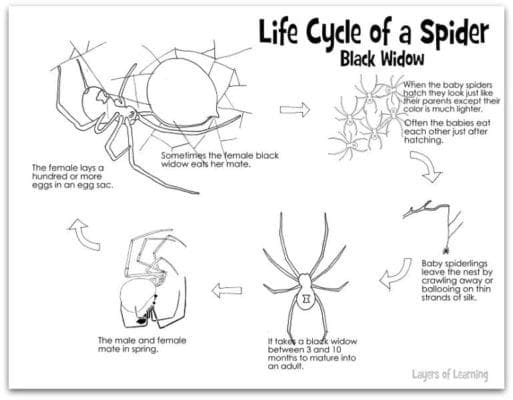This exploration is for all ages, as the colored smilies show. You can explore the life cycle of a spider with your whole family together!




The life cycle of a spider exploration is a Biology experiment from the Layers of Learning Invertebrates unit. Layers of Learning has coloring and printables in every unit of this family-friendly curriculum. Learn more about Layers of Learning.
Spiders are arthropods. They have a hard exoskeleton. Since they have eight legs and no antennae, they are in their own class: Arachnida. Arachnids are predators and carnivores. They often kill their prey with venom and then spit digestive juices from their stomachs onto the body of their dead prey, dissolving it before sucking up the pre-digested bits. Learn about the life cycle of a spider with us.
Step 1: Library Research
Before you begin exploring, read a book or two about spiders. Here are some suggestions, but if you can’t find these, look for books at your library about spiders or arachnids. The colored smilies above each book tells you what age level they’re recommended for.
As Amazon affiliates, the recommended books and products below kick back a tiny percentage of your purchase to us. It doesn’t affect your cost and it helps us run our website. We thank you!

Spiders
by Gail Gibbons

Step 2: Spider Life Cycle Exploration
To complete this exploration you need the spider life cycle printable and some crayons or colored pencils.
Black widow spiders mate in spring and early summer. The male is about half the size of the female. Though the black widow does sometimes eat her mate after breeding, this is not always or even usually the case. When the female black widow does feed on her mate it is because she is low in nutrients and needs the energy.
After mating, the female black widow weaves a round or pear shaped nest of silk into which she deposits her eggs. The web of the black widow is random and messy looking, not symmetrical and neat like some spiders. Female black widows can mate and lay three or more egg sacs a season. Hundreds of eggs are laid in each egg sac. The mother black widow guards the egg sac for up to a month until it hatches.
When the baby spiders hatch they begin to eat one another for nutrients, so only a few from each egg sac survive. The survivors leave the egg sac within a couple of days of hatching. When they leave they often “balloon”. The baby spiders spin a long filament of web and it catches a breeze and floats them away from home.
The baby spiders molt several times over the summer and fall. Over winter they mature and in the spring they are ready to find their own mates and start the cycle over again. Most black widows live only one year, but they can live up to three years.
Now color the Life Cycle of a Spider printable.
Step 3: Show What You Know
Put your colored printable life cycle page in your science notebook. Explain in your own words how a black widow grows from egg to adult to laying more eggs.
Additional Layers
Additional Layers are extra activities you can do or tangents you can take off on. You will find them in the sidebars of each Layers of Learning unit. They are optional, so just choose what interests you.
Writer’s Workshop

A lot of people are very afraid of spiders. They bite and the way they move is spooky. Are you afraid of spiders? Write about an animal you are afraid of. Describe in detail what about that animal scares you.
Additional Layer
Learn which dangerous spiders live in your area and how to identify them.

Learn what to do if you get bitten. Some spider bites are very dangerous and painful.
Deep Thoughts
There are more than 45,700 known species of spiders. Scientists have proposed more than 20 different ways to classify these spiders within the Arachnid family since 1900. Taxonomy, or the groups we put living things in, can change depending on which characteristics we think are the most important.
Which characteristics do you think are most important in sorting them? Habitat? Hunting? Mating? Body shape?
Now you’re thinking like a taxonomist.
Get a Free Unit
Choose between the first unit in each Layers of Learning subject to try for free when you sign up for the newsletter.
We never spam and you can cancel your subscription at any time.






